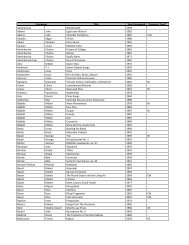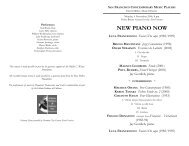From the Top - San Francisco Contemporary Music Players
From the Top - San Francisco Contemporary Music Players
From the Top - San Francisco Contemporary Music Players
Create successful ePaper yourself
Turn your PDF publications into a flip-book with our unique Google optimized e-Paper software.
than disjunctions in his oeuvre, as musicologist Steven Johnson observes:<br />
“Th roughout his career, [Feldman] adhered with remarkable consistency<br />
to a few tenets he learned from [New York’s abstract impressionist<br />
painters]: a dislike of intellectual system and compositional rhetoric; a<br />
hostility to past forms of expression; a preference for abstract gestures set<br />
in fl at ‘all-over’ planes of time; an obsession with <strong>the</strong> physical materials<br />
of art; a belief in handmade methods; and a trust in instinct.”<br />
Like Cage, Feldman calls attention to individual sounds–and to <strong>the</strong><br />
silences that separate <strong>the</strong>m. His works grow like crystals: modular, at<br />
fi rst glance even random, yet often highly structured. In her writings<br />
on American experimental music, Elena Dubinets has observed that<br />
“Th e sounds in [Feldman’s] music should fl ow gently and be heard out<br />
to <strong>the</strong> end, without being interrupted by o<strong>the</strong>r sounds. His works are<br />
full of many singular ‘sound-lives’ which are intended to sound out until<br />
<strong>the</strong>ir complete decay.” But more than Cage, Feldman seems to have<br />
cultivated his garden of sounds to create an atmosphere that is distinctly<br />
devotional, perhaps even <strong>the</strong>rapeutic in quality. As a result, even familiar<br />
sounds invite, or maybe require, a spirit of re-discovery. “All I ask,”<br />
Feldman once explained, “is that composers wash out <strong>the</strong>ir ears before<br />
<strong>the</strong>y sit down to compose.”<br />
Feldman, <strong>the</strong> viola in my life (1) (1972)<br />
for solo viola, fl ute, percussion, piano, violin, and cello<br />
Th ough it was composers whom Feldman advised to wash out <strong>the</strong>ir<br />
ears, listeners can experience <strong>the</strong> same type of aural cleansing in Feldman’s<br />
sextet <strong>the</strong> viola in my life (1), not because of any rushing torrents<br />
of sound but, on <strong>the</strong> contrary, because each note or chord or motif, like<br />
a drop of water, contains its own microsystem of sound. Until <strong>the</strong> fi nal<br />
few moments, where an element of repetition gradually insinuates itself<br />
into audibility, Feldman’s sound-islands fl oat characteristically unte<strong>the</strong>red<br />
to discernible melodic or harmonic schemes. What comes to <strong>the</strong><br />
fore instead is tone color and, in a statuesque sort of way, <strong>the</strong> presence<br />
of <strong>the</strong> performers, whose tightly controlled movements turn a tapestry<br />
into a tableau vivant.<br />
SAN FRANCISCO CONTEMPORARY MUSIC PLAYERS<br />
8<br />
Steve Reich [b. 1936]<br />
“I am interested in perceptible processes. I want to be able to hear <strong>the</strong><br />
process happening throughout <strong>the</strong> sounding music. To facilitate closely<br />
detailed listening a musical process should happen extremely gradually.<br />
Performing and listening to a gradual musical process resembles: pulling<br />
back a swing, releasing it, and observing it gradually come to rest; turning<br />
over an hour glass and watching <strong>the</strong> sand slowly run through to <strong>the</strong><br />
bottom; placing your feet in <strong>the</strong> sand by <strong>the</strong> ocean’s edge and watching,<br />
feeling, and listening to <strong>the</strong> waves gradually bury <strong>the</strong>m.” For students of<br />
new music, it can come as a shock to realize that <strong>the</strong>se words, by composer<br />
Steve Reich, were written more than forty years ago. Although<br />
Reich has long since departed from <strong>the</strong> stricter type of so-called “process<br />
music” that he advocated in <strong>the</strong> 1960s, his scores still exhibit a fascination<br />
with patterning–sometimes hypnotic, sometimes fostering a heightened<br />
sensory awareness, an attention that is physical, even tactile, yet<br />
curiously detached from <strong>the</strong> ebb and fl ow of human emotion.<br />
Many impulses coalesced in <strong>the</strong> creation of Reich’s process-oriented<br />
scores, chief among <strong>the</strong>m: 1) a reaction against <strong>the</strong> intricate and<br />
largely inaudible processes of serial (twelve-tone) and “chance” (aleatory)<br />
composition, 2) new methods of combining sounds enabled by<br />
electronics, especially tape loops, and 3) <strong>the</strong> infl uence of African and<br />
o<strong>the</strong>r non-western musics that emphasize rhythmic patterning and<br />
interlocking textures. Like <strong>the</strong> o<strong>the</strong>r so-called “minimalist” composers<br />
(Terry Riley, Philip Glass, and sometimes John Adams), Reich favored<br />
discrete musical fragments–single melodic phrases, simple harmonies–<br />
as his compositional building blocks. Using tape loops of spoken text<br />
( It’s Gonna Rain, 1965; Come Out, 1966), he pioneered a technique of<br />
phased repetition whereby two identical recordings begin in unison but<br />
gradually move out of sync with one ano<strong>the</strong>r. In 1967, Reich began to<br />
transfer this technique to live performance with his Violin Phase and<br />
Piano Phase, works that generate endless rhythmic variety from <strong>the</strong> overlapping<br />
of a single phrase of music and <strong>the</strong> sheer concentration required<br />
from <strong>the</strong> performer.<br />
California can claim partial responsibility for Reich’s interest in African<br />
drumming, which was sparked in <strong>the</strong> early 1960s after he had arrived<br />
for graduate work at Mills College (with degrees in philosophy and composition<br />
from Cornell and Juilliard already in hand). While a student<br />
of Darius Milhaud and Luciano Berio, he attended a composers’ con-<br />
SAN FRANCISCO CONTEMPORARY MUSIC PLAYERS<br />
9




